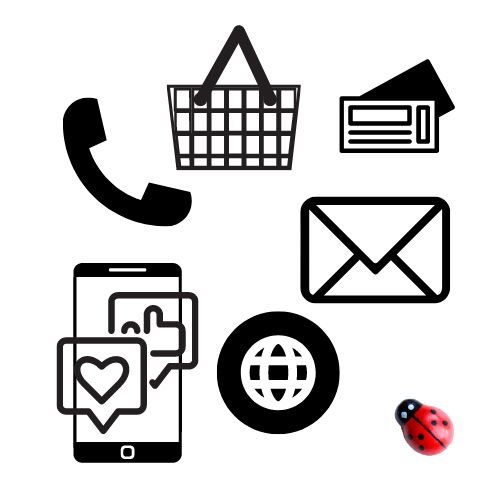
In the ever-evolving landscape of digital marketing, our clients want to know how to navigate the complexities of reaching their target audience seamlessly across various channels. This is where omnichannel marketing steps in as an indispensable strategy. In this article, we delve into the omnichannel marketing essentials: its definition, strategies, and why it’s imperative for businesses aiming to thrive in today’s competitive market. Whether you’re a seasoned marketer or just diving into the digital realm, understanding and implementing these key principles will undoubtedly amplify your marketing efforts and drive exceptional results. Let’s embark on this journey to unlock the power of omnichannel marketing together.
Contents

1. What is Omnichannel marketing?
Omnichannel marketing is a strategic approach that aims to provide a seamless and integrated customer experience across multiple channels and touchpoints. Key elements of omnichannel marketing include:
- consistency, ensuring a uniform brand message and design across all channels;
- integration, synchronizing data and communication channels to facilitate smooth transitions for customers;
- personalization, leveraging customer data to deliver tailored content and offers;
- flexibility, allowing customers to switch between channels without disruption; and
- customer journey mapping, understanding and optimizing the customer journey to enhance engagement and satisfaction.

By adopting an omnichannel strategy, businesses can enhance customer satisfaction, foster brand loyalty, and drive better business outcomes by delivering a cohesive and connected experience across all customer interactions.
2. How to build an omnichannel marketing campaign?
Building an omni-channel marketing campaign involves creating a cohesive and integrated strategy that delivers consistent messaging and experiences across multiple channels to reach and engage customers effectively. Here’s a step-by-step guide to help you build an omni-channel marketing campaign:

- Understand Your Audience: Start by understanding your target audience, including their demographics, preferences, behaviors, and preferred communication channels. This will help you tailor your campaign to their needs and preferences.
- Set Clear Objectives: Define specific and measurable goals for your omni-channel marketing campaign. Whether it’s increasing brand awareness, driving sales, or improving customer engagement, make sure your objectives are well-defined and aligned with your overall marketing strategy.
- Develop a Unified Message: Craft a consistent and cohesive message that will resonate with your audience across all channels. Your messaging should reflect your brand identity and values while addressing the unique characteristics of each channel.
- Choose Relevant Channels: Identify the most appropriate channels to reach your target audience based on their preferences and behaviors. This could include social media, email, SMS, website, mobile apps, physical stores, and more.
- Integrate Channels: Ensure seamless integration and consistency across all channels to provide a unified experience for your customers. This may involve using marketing automation tools, customer relationship management (CRM) systems, and other technologies to sync data and communication efforts.
- Personalize Content: Leverage customer data and insights to personalize your content and messaging for different segments of your audience. Personalization can help increase engagement and conversion rates by delivering relevant and timely content to each individual.
- Optimize Customer Journeys: Map out the customer journey across all channels and touchpoints to identify opportunities for optimization and improvement. Streamline the path to purchase and remove any friction points that may hinder the customer experience.
- Measure and Analyze Results: Track key performance indicators (KPIs) to evaluate the effectiveness of your omni-channel marketing campaign. Monitor metrics such as engagement rates, conversion rates, ROI, customer satisfaction, and lifetime value to gauge the impact of your efforts.
- Iterate and Improve: Use insights from your analytics to iterate and refine your omni-channel marketing strategy over time. Continuously test different approaches, channels, and messaging to optimize performance and drive better results.
- Provide Consistent Support: Offer consistent support and assistance to customers across all channels, including pre-sale inquiries, post-purchase support, and ongoing communication. Delivering exceptional customer service can help build trust and loyalty with your audience.
3. What are the best examples of omnichannel marketing?
Several companies have excelled in implementing omnichannel marketing strategies to create seamless and integrated experiences for their customers. Here are some of the best examples:

Conclusion
In conclusion, omnichannel marketing has become an essential strategy for businesses aiming to provide seamless, personalized experiences across various channels. We’ve explored what omnichannel marketing is, delved into its key strategies, discussed the steps to build a successful omnichannel campaign, and highlighted some exemplary examples in the field.
By understanding the importance of consistency, integration, and customer-centricity, businesses can leverage omnichannel marketing to foster stronger connections with their audience, enhance brand loyalty, and ultimately drive revenue growth. As technology continues to evolve and consumer behaviors shift, embracing an omnichannel approach will undoubtedly remain a cornerstone of successful marketing strategies in the digital age.
If you have any questions about your omnichannel campaign strategy, please contact us by phone or e-mail. We’ll be happy to help. Read also: “From Inbox to Income: Successful SMS and e-mail campaigns“.
Please share this article on your social networks, and if you have any questions, send us an e-mail. Follow our Pinterest page regularly for visual inspiration and new ideas.


